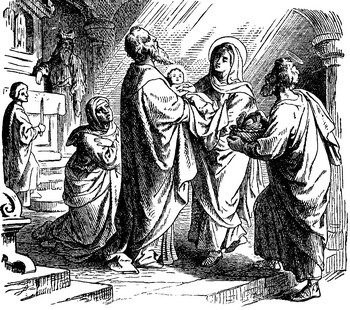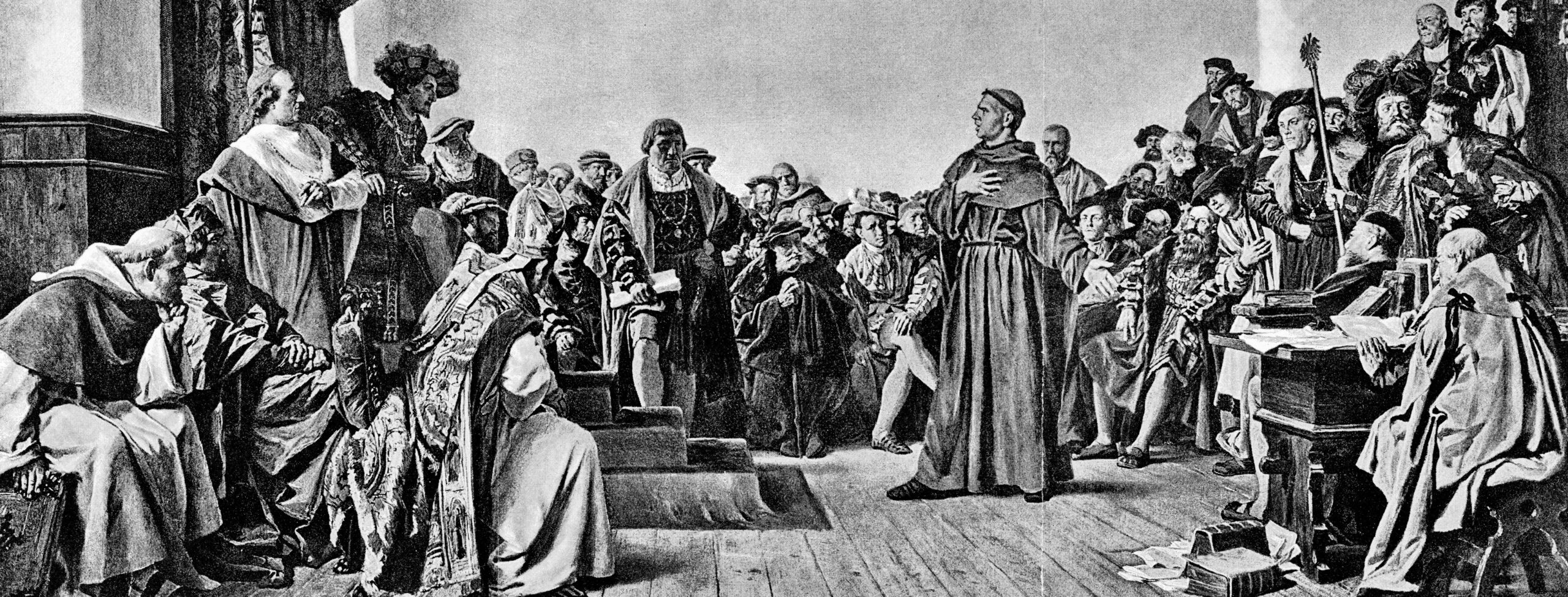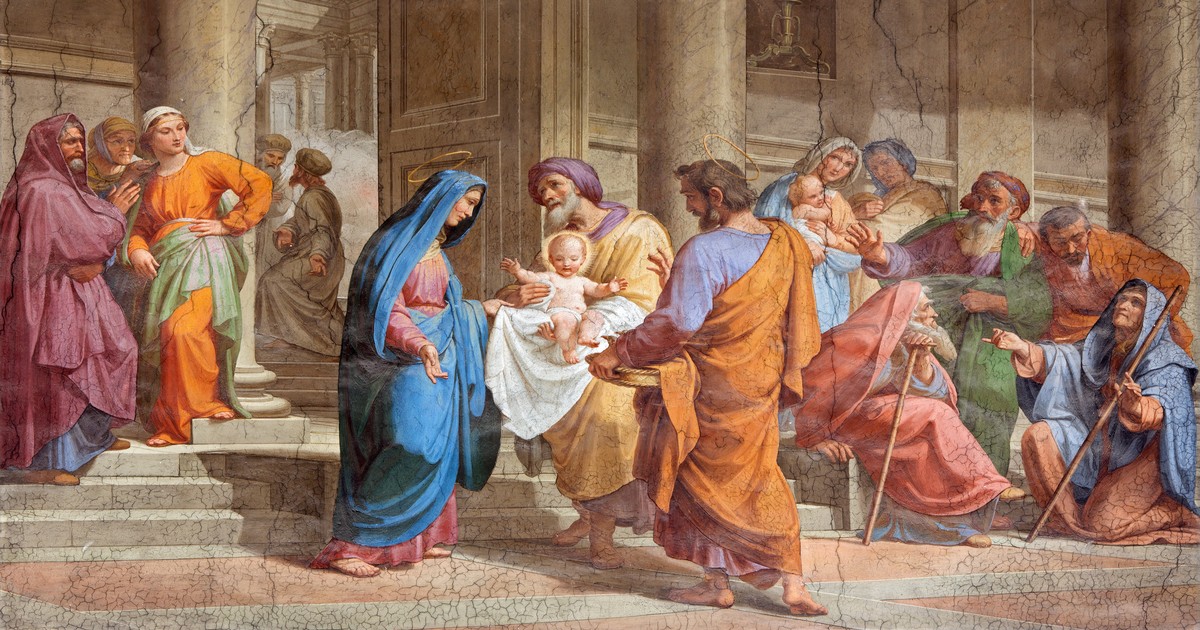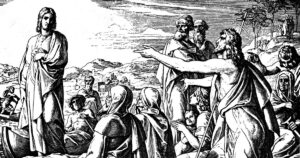Nunc Dimittis: Seeing God’s Savior and Salvation
by T. R. Halvorson
NOTE: This article may be downloaded as a PDF Document
Introduction
Nunc Dimittis (the Song of Simeon) as a post-Communion canticle is a treasure. It holds deep riches of consolation in God’s Savior and salvation. Receiving the true body and blood of Christ with bread and wine is the climax of the Divine Service. But then what? Nunc Dimittis is a fitting and blessed anticlimax when we understand why it is used here.
This article begins by noting that this use of Nunc Dimittis is peculiarly Lutheran. Since it is peculiar, this article asks why Lutherans do it. To find the answer, we begin by recalling the essence of the Service of the Sacrament in Lutheran worship. This helps us focus our inquiry by asking, does Nunc Dimittis fit that essence.
We encounter an initial obstacle to this song fitting in Communion. The historical use of the song was in Compline and Vespers. The reasons for that are clear and strong based on one aspect of the song. That is why many, including some Lutheran liturgists, view the use of Nunc Dimittis in Communion as curiously borrowed from Compline and Vespers and misplaced in the Divine Service.
But that critique overlooks another major aspect of the song. Beginning in 1522, Lutherans have used Nunc Dimittis in Communion. There is a simple and powerful reason for this. The reason is tied to the heart of the Lutheran understanding of the Sacrament. This heart-tie between the Song of Simeon and the Sacrament unfolds in layers of Word, hearing, seeing, and receiving. With understanding, amazement floods the worshiper in each layer. Overwhelming amazement and consolation in God’s Savior and salvation evoke desire for expression. The Song of Simeon gives us the expression we need.
Why This One Peculiarly Lutheran Addition?
Larry Peters says:
Truthfully, there is little that can be identified as Lutheran in the Lutheran liturgy. We are, after all, evangelical catholics and we joyfully treasured the Mass as it came to us, albeit cleansed from some of the accretions that had overwhelmed its form and content. But we did add one little thing to the Mass that is a distinctly Lutheran addition. That is the placement of the Nunc Dimittis as the Post-Communion Canticle.[1]
“The Nunc dimittis at this place is a Lutheran peculiarity.”[2] It has been called a “curious borrowing” from Compline and an “intrusion” with a “forced meaning.”[3] William Weedon notes:
Given such slight antecedent, its remarkably strong position in American Lutheranism is most likely to be found in it being included in Loehe’s Agenda. The early Missouri Synod books never list it, since it was not part of the Herzog Heinrich tradition.[4]
This raises the question: Since hardly anyone else does this,[5] why do Lutherans?
The Service of the Sacrament Keeps Its Focus
In Lutheran worship, the Service of the Sacrament has a simple core. The service does not stray from it. Every part holds closely to its center. The core and center are like the string of a necklace. All the pearls of the service are strung on this string. Nothing but pearls are here.
What is the core, the center, the string? It is this: The Real Presence of Christ.
Christ’s Words of Institution make the Sacrament. He said of the bread, “This is my body,” and so it is. He said of the wine, “This cup is the new testament in my blood” and so it is. He said, “shed for you,” “take,” “eat,” and “drink.” He said his blood “is shed for you for the forgiveness of sins.” Luther says in the Small Catechism, “Whoever believes these words has exactly what they say, ‘forgiveness of sins.’”
Because of his Word, the bread of the Sacrament is the true body of Christ. Because of his Word, the wine of the Sacrament is the true blood of Christ. The blood of Christ brings what He shed it for, the forgiveness of sin. Giving you his blood to drink, Christ gives you forgiveness and the peace forgiveness brings.
The pearls of the service begin with the Preface speaking plainly of presence. The Preface says, “The Lord be with you.” Continuing from there, the Sanctus (“blessed is He that comes”), the Pax (“The peace of the Lord be with you always”), the Agnus Dei (our greeting to the sacramentally present “Lamb of God that takes away the sin of the world”), and all the parts of the service are pearls of Real Presence. They are not some other matter. The service never loses focus.
Does Nunc Dimittis Fit?
Can we say the same for Nunc Dimittis? Does Nunc Dimittis fit with the Words of Institution like the Preface, the Pax, and Agnus Dei do?
Nunc Dimittis is the Song of Simeon in Luke 2.
And behold, there was a man in Jerusalem whose name was Simeon, and this man was just and devout, waiting for the Consolation of Israel, and the Holy Spirit was upon him. And it had been revealed to him by the Holy Spirit that he would not see death before he had seen the Lord’s Christ. So he came by the Spirit into the temple. And when the parents brought in the Child Jesus, to do for Him according to the custom of the law, he took Him up in his arms and blessed God and said:
“Lord, now You are letting Your servant depart in peace,
According to Your word;
For my eyes have seen Your salvation;
Which You have prepared before the face of all peoples,
A light to bring revelation to the Gentiles,
And the glory of Your people Israel.”
Nunc Dimittis gets its name from the first words of the Latin version, “Nunc dimittis” meaning “Now you dismiss.”
Use of Nunc Dimittis Historically: Compline and Vespers
Initially, there seems to be an obstacle to this song fitting as a Communion canticle. With few exceptions, Nunc Dimittis was not used in the Mass before Lutherans started to use it in the 16th century. In his master’s thesis, Paul J. Grime says:
With the exception of St. John Chrysostom’s liturgy and a few liturgies from the medieval period, this specific use of the Nunc dimittis has been limited to the churches of the Reformation, and most predominantly to the Lutheran Church.[6]
“The earliest occurrence of the Nunc dimittis in a eucharistic context appears to be in the liturgy of St. John Chrysostom (c. 347-407).”[7] “In the centuries that followed Chrysostom’s liturgical work, the Nunc dimittis did appear in some eucharistic liturgies.”[8] Nunc Dimittis “in the Greek Church is said at the close of the Liturgy.”[9] Outside of those exceptions, John W. Kleinig says “Nunc Dimittis traditionally has been used in Compline and Vespers.”[10] Luther D. Reed says, “The Nunc Dimittis is a canticle which properly belongs to Compline from which office it came into the Lutheran Vespers.”[11]
It is not difficult to understand why the Nunc Dimittis came to be used during the evening hours. William O’Shea remarks that in its use in the Compline,
It is singularly appropriate at the close of the day when the darkness of night, symbol of death and the prince of darkness, has set in. Only the light of Christ can dissipate the darkness by conquering Satan and death at the same time.
In reflecting on the Nunc Dimittis and Simeon’s apparent readiness to depart this life, Parsch says that “. . . we may use this song as a night prayer for this life, since, as we know, Compline is also a prayer for a good death.”[12]
Reed’s treatment of using Nunc Dimittis in Communion, while somewhat commendatory, remains brief and lukewarm. He consigns it “properly” to Compline and Vespers. F. R. Webber’s treatment is even less enthusiastic. He characterizes the use as both a borrowing and curious. He speaks of “The curious borrowing of the Nunc Dimittis from the Office of Compline, and inserting it here,” as a post-Communion canticle.[13] Webber goes on to say:
Although most modern writers praise the Nunc Dimittis as a thing singularly appropriate in this place, yet there are some who believe that it was a later intrusion, and that a meaning is forced into it in this particular part of the service, that was not intended by the inspired writers of the Scriptures.[14]
The use of Nunc Dimittis in Compline and Vespers at the end of the day focuses on the dismissal, departure, or death aspect of the song. That aspect certainly is not only present but pronounced. But Simeon’s song is incomplete with a departure that lacks peace. He sang not about mere departure but departure in peace. “Now You are letting Your servant depart in peace.” What produces Simeon’s peace? His words identify two sources or grounds of peace:
- According to Your word;
- For my eyes have seen Your salvation.
“According” and “for” are words that flag the source and ground of peace. Peace is “according to Your word.” Simeon has peace “for my eyes have seen Your salvation.” If there were no Word of God or sight of salvation, there would be no peace and no departure in peace. The lukewarm treatments of Nunc Dimittis in Communion overlook this aspect of Simeon’s song. That is why they see its use in the Divine Service as a curious borrowing or a misplaced intrusion. They miss the reason Lutherans use Nunc Dimittis: Real Presence and the words of Simeon’s song that sing Real Presence.
Lutheran use of Nunc Dimittis
It is well known that Luther recovered the Sacrament of the Altar from the Papist error that had turned it into a sacrifice priests offer to God rather than a sacrament Christ gives to the Church. This had many well-documented implications and effects on the liturgy of the Sacrament.[15]
Luther also recovered the Sacrament from the Papist error of transubstantiation on the one side and the Reformed error of symbolism on the other side. We call what he recovered Real Presence. In the Small Catechism, we use the words “true body” and “true blood.” The effects of this on the liturgy of the Sacrament are, I fear, less well appreciated.
William D. Maxwell says, “Luther’s idea of fellowship involved belief in the Real Presence.”[16] He elaborates as follows:
Central to Luther’s conception of the Lord’s Supper was the fellowship of Christians in and with the living Lord. This idea is prominent in the New Testament, particularly in the early chapters of the Book of the Acts, but it had been largely lost in the teaching of the medieval Church. It fell to Luther to rediscover it, and in his early writings especially he gave it a conspicuous place. This recovery alone changed the whole aspect of worship. No longer could it remain merely a spectacle splendidly enacted as it were upon a stage; it must become a common action in which all shared.[17]
Thus Luther had two criteria in his liturgical reform:
- Sacrament as testament (gift) and not sacrifice.
- Participation of believers in the fellowship of Real Presence
We can see his application of the first criterion in, for one example, his severe deletions of the Canon of the Mass.[18] That is a huge subject for a different article.
But what happened in Lutheran liturgical reforms to apply the second criterion? Some examples include saying or singing the Words of Institution so that the laity could hear them, having the laity sing canticles and not have them sung only by the choir, and so on. With this criterion in place and impetus in motion, other things also began to happen, even if not done by Luther himself.
F. R. Webber says, “The curious borrowing of the Nunc Dimittis from the Office of Compline, and inserting it here may be traced to Bugenhagen’s liturgy of 1524, Dober’s of 1525, and the 1525 Strassburg Order.”[19] So let’s begin with Johannes Bugenhagen. Who was this man? Why would it matter what he did with the liturgy?
Bugenhagen was Luther’s own pastor and confessor. He married Martin and Katharina. He preached at Luther’s funeral. He is called the Second Apostle to the North.
Johannes Bugenhagen (1485–1558) was a pivotal figure in the organization of the Lutheran movement in northern Germany and in parts of Scandinavia. His writings and diverse reforming activity made a lasting impression on church administration, education, the care of the poor, worship, and theology.[20]
Bugenhagen published church orders for many parishes. He published an evangelical Mass in 1524.[21] He drew Nunc Dimittis from Compline into the Divine Service as an application of Luther’s second criterion of liturgical reform, the participation of believers in the fellowship of Real Presence. In Concerning the Evangelical Mass, Bugenhagen said,
The mass is a testament of Christ in which all believers in Christ are promised forgiveness of sins. … Take the words of the mass for yourself and contemplate them properly in faith so that you do not doubt that, as Christ promises you, so it happens to you, and in faith in the same words receive the honorable sacrament as a certain, holy sign in which what is promised happens to you. Through it your heart is directed to believe the words.[22]
Note this: “a certain, holy sign in which what is promised happens to you.” How does what is promised happen in the sign? How does the sign deliver what the testament promises? Bugenhagen says, “You have present here the truly living sign and seal, His body and His blood. Believe the words and the sign, and you will obtain the promised inheritance.”[23] Look how he talks about what is present, about the sign and seal being truly living, His body and His blood. These words are a saturated expression of Real Presence. Bugenhagen wants the Christian to participate in the new testament in Christ’s blood, in the fellowship of Real Presence.
Bugenhagen includes in his order for the Mass the following:
The priest may in the meantime pray thusly with the people: “Oh most gracious Father, merciful God, help so that this bread and wine may become for us the true (p. 18) body and the innocent blood of your dearest Son, our Lord Jesus Christ. Amen.”[24]
Here Bugenhagen involves the priest and congregation together in praying — in so many words — that the bread and wine will be the true body and blood of Christ, the Real Presence.
Having added that prayer upon the Words of Institution, Bugenhagen carries through his idea of involving the Christians in Real Presence into his text of Nunc Dimittis. He actually changes the text to place the congregation straight into Simeon’s experience and worship of Christ.
“O Lord, let your servants depart in peace according to your word. For our eyes have seen your Savior whom you have prepared before the countenance of all people, a light to enlighten the Gentiles and as glory of your people Israel”[25]
See that? “Your servants,” not “Your servant.” “Our eyes have seen,” not “my eyes have seen.” “Your Savior,” not “Your salvation.” Our eyes see the body and blood of Christ. This does not omit seeing salvation, but our physical eyes see the person of Christ while faith receives with his person His work. Grime says, “By use of the phrase ‘my eyes’ he stresses the reality of his vision of God’s salvation.”[26]
Before long, the following Lutheran liturgies produced during the Reformation used Nunc Dimittis as a post-Communion canticle:[27]
- Nordlingen 1522
- Bugenhagen 1524
- Nurnberg 1525
- Doeber 1525
- Strasburg 1525
- Slueter 1531
- Swedish 1531 (Olaus Petri)
Following the Reformation, this Lutheran use of Nunc Dimittis is continues in:
- Braunschweig-Luneberg Order 1657[28]
- Löhe Agende 1844[29]
- Common Service 1888[30]
- Norwegian Evangelical Lutheran Church 1915[31]
- LCMS Liturgy and Agenda 1917[32]
It is in our modern service books: The Lutheran Hymnal (1941), Service Book and Hymnal (1958), Lutheran Worship (1982), Lutheran Hymnal with Supplement (1984), Ambassador Hymnal (1994), Evangelical Lutheran Hymnary (1996), and Lutheran Service Book (2006).
Simeon and What He Saw
Olaus Petri, Bishop of Stockholm,[33] published The Swedish Mass, as it is Celebrated in Stockholm, With Reasons for Conducting it in Such Manner, 1531. Eric Esskildsen Yelverton provides a succinct explanation of Petri’s use of Nunc Dimittis.
The Nunc dimittis is given as a communion hymn: historically it was the spontaneous utterance of the aged Simeon when first he beheld the incarnate Son of God; and here it is intended to represent the cry of the human heart at the vision of Him, whose sacramental presence is “a light to lighten the Gentiles.”[34]

Note the correspondence between the presence of Christ in the temple and the sacramental presence of Christ in bread and wine. Simeon saw Jesus in the temple and in the true body and blood of Christ, so do we. With Real Presence, Christ is as present for us as He was for Simeon. In Simeon’s sight of Jesus’ body he saw his Savior. In our sight of the bread of Communion we see the body of our Savior.
Grime says, “Simeon’s God is in his arms! Could God get any closer, or become any more personal than that? When Christ’s faithful people receive their Lord’s body and blood in the sacrament, Christ comes to them as surely as He came to Simeon.”[35] John T. Pless says, “Like Simeon who held the incarnate Savior in his arms, we have received the body and blood of our Lord into our mouths and so we bless Him for His redemption.”[36] William Weedon says:
Lutheran Worship, by its use of the Nunc Dimittis, confesses that in the sacrament just received the communicants have had the experience of old Simeon, who saw with his own eyes the Salvation of Israel and the Light for the Gentiles when he held the baby Christ in his arms; he was ready to die then in peace. The particular placement of this canticle, which has only slight Reformation antecedents, and comes into Missouri Synod practice chiefly from the adoption of the Common Service, is nothing less than a confession that a genuine encounter between Christ and his people has taken place at the altar. It is thus a confession of the real presence.[37]
Burnell F. Eckardt Jr. says:
When [Simeon] at last sees the Child, with the words “My eyes have seen Your salvation” he is in effect saying, Now I can die in peace. Likewise we Christians, when we receive this same Christ at the altar, appropriately say the same thing as he. For we do not see the flesh of His Body, but we do see His Body all the same, for this bread is, as the Apostle says, the Communion of the Body of Christ, which means that the bread and Christ’s Body have communed together and become one substance. Thus, beholding the bread, we behold Christ’s Body; for they are the same thing. And we do not take Him into our arms, but receive Him by mouth, for He said, “Take, eat; this is My Body.” Hence we, in as authentic a way as did Simeon, behold and receive Christ at the altar, and so we, according to the same faith as he expressed, say the same words, in effect meaning, Now I can die in peace. That is, now I can face anything and everything which the world, the flesh, and the devil may cast in my path, for my eyes have seen God’s salvation; I have received my Christ here.[38]
John W. Sias says:
This canticle is often treated as a “proper,” that is, a part of the service that varies from week to week, but since Wilhelm Löhe’s selection of the Nunc Dimittis in his 1844 Agenda it has become virtually an “ordinary” in many Lutheran churches. One might suspect this is so because it so clearly proclaims what Lutheran churches in particular believe the Lord has just brought about for us in his Supper, namely, his true presence in body and blood, under the bread and wine, and to deliver nothing less than forgiveness of sins, life, and salvation.[39]
This dual seeing — Savior and salvation — is warranted by Luke’s text. Consider the translations by Tyndale, Coverdale, and Luther. Tyndale translates it, “For myne eyes have sene ye saveour sent fro ye.” Coverdale translates it, “For myne eyes haue sene thy Sauioure.” Luther translates it, “denn meine Augen haben deinen Heiland gesehen” (for my eyes have seen your Savior). Grime says,
The object which Simeon’s eyes saw, το σωτήριον is the focal point of this verse. The adjective σωτήριον is used here as a noun. The meaning which this substantived adjective has acquired in the New Testament is that of “. . . messianic salvation and the one who meditates it.”[40]
See how the two are joined, the messianic salvation and the one who mediates it, in a single object seen with the eyes.
Simeon saw the incarnational presence of God in the body of the boy, Jesus. With that presence, his eyes saw salvation. We see the sacramental presence of the body and blood of Jesus with the bread and wine. With that presence, we see what He shed his blood for, the forgiveness of sins.
Hearing, Seeing, Receiving
Just as το σωτήριον has (what I believe to be) an intentionally dual meaning in Luke’s text, the name Simeon also has a dual meaning that connects directly to Luther’s theology, the reform of the Mass, and the use of Nunc Dimittis in Communion.
The name is derived from Simeon, son of Jacob and Leah, patriarch of the Tribe of Simeon. Leah “conceived again and bore a son, and said, ‘Because the LORD has heard that I am unloved, He has therefore given me this son also.’ And she called his name Simeon.” (Genesis 29:33). This name is derived from shama meaning to hear with intelligence, to hear with attention, and to hear with diligence.
For Leah, the Lord heard. Over time, however, the direction of speaker and hearer was reversed. In classical rabbinical sources, the name Simeon sometimes is interpreted as meaning “he who listens [to the words of God]” (Genesis Rabbah 61:4) So Simeon hears the Word of God. “It had been revealed to him by the Holy Spirit that he would not see death before he had seen the Lord’s Christ.” (Luke 2:26) He heard that he would see. He sings of these two elements, hearing the Word and seeing: “According to Your word; For my eyes have seen.” In his devotion, Simeon is a man who hears with attention and diligence. Because he hears, he sees. He sees the boy Jesus and says, “My eyes have seen your Savior” and “My eyes have seen your salvation.”
The Verba — the Words of Institution — are the scalpel Luther used to cut away the cancer of the Canon of the Mass and center the Service of the Sacrament directly and only upon the Word of God. Luther bids us all to be Simeon, to hear the Words of Institution with attention and diligence, to disregard all distractions, to see the true body and blood of Christ, and with his blood receive the forgiveness of sin. Having heard, we see, and seeing we are like a second meaning of the name Simeon, “the God-receiver.” In the Eastern Orthodox tradition, Simeon is commemorated with Anna the Prophetess on February 3 on the Feast of the Holy and Righteous Simeon the God-Receiver and Anna the Prophetess. Word hearers are God receivers, Simeons at the Communion rail. We hear the Word, see the Real Presence, receive the true body and blood, Savior and salvation together, in bread and wine in our mouths. We are God-receivers.
These words of thanksgiving amaze even Joseph and Mary! A stranger was proclaiming their crying, squirming little Son to be “glory,” “a light of revelation,” and even “salvation” itself! What could be more amazing or astonishing than this? For us, it is that we get to say the very same words to the very same Christ. Because He is bodily present in the Lord’s Supper, our eyes of faith see the very same flesh and blood that Simeon, through the Holy Spirit, saw. Where Simeon looked and beheld the Messiah in the Child, we look and behold the Messiah in Bread and Wine. As Jesus tangibly and physically lived in historical Palestine, today Jesus lives among us tangibly and physically in Bread and Wine. It was amazing and unbelievable to Joseph and Mary that Simeon said these things about their Child, it is equally amazing and unbelievable to most people, even other Christians, that we confess Christ is present in such lowly, earthly things as Bread and Wine. But Christ has said it, and so we say it back to Him in the liturgy.[41]
It should be no wonder that, once Luther recovered Real Presence in the Sacrament, of course Lutherans would break out singing with Simeon, Nunc Dimittis.
[1] Larry Peters, “I understand why Luther loved the Nunc Dimittis,” Pastoral Meanderings, March 2, 2013, http://pastoralmeanderings.blogspot.com/2013/03/i-understand-why-luther-loved-nunc.html, accessed August 29, 2020.
[2] Paul J. Grime, The Use of the Nunc Dimittis in the Liturgy of the Eucharist (unpublished M.Div. Thesis) (Fort Wayne, IN: Concordia Theological Seminary Library, 1986), 9.
[3] F. R. Webber, Studies in the Liturgy, (Ashby Printing Company, Erie, Pennsylvania, 1938), 158.
[4] William Weedon, The Liturgical Confession of the Lord’s Supper in Five Representative Orders of 16th Century Lutheranism, April 1998 (Thesis, Master of Sacred Theology), 81, n. 23.
[5] We will note some exceptions during the course of our consideration.
[6] Grime, Use of Nunc Dimittis, i.
[7] Grime, Use of Nunc Dimittis, 3.
[8] Grime, Use of Nunc Dimittis, 4.
[9] Edward T. Horn, Outlines of Liturgics, 2nd & rev. ed. (Philadelphia: The Lutheran Publication Society, 1912), 63.
[10] John W. Kleinig, Course Notes for Liturgics (North Adelaide: Australian Lutheran College, 2009); and F. R. Webber, Studies in the Liturgy, (Ashby Printing Company, Erie, Pennsylvania, 1938), 158.
[11] Luther D. Reed, The Lutheran Liturgy (Philadelphia: Muhlenberg Press, 1947), 379.
[12] Grime, Use of Nunc Dimittis, 3.
[13] Webber, Studies in the Liturgy, 158.
[14] Webber, Studies in the Liturgy, 158.
[15] Bryan D. Spinks, Luther’s Liturgical Criteria and His Reform of the Canon of the Mass (Bramcote/Nottingham: Books Ltd., 1982); Vilmos Vajta, Luther on Worship (Philadelphia: Muhlenberg Press, 1958) (especially Chapter 2, “Beneficium and Sacrificium”); Carl F. Wisloff, The Gift of Communion: Luther’s Controversy with Rome on Eucharistic Sacrifice, Joseph M. Shaw trans. (Minneapolis: Augsburg Publishing House, 1964); John R. Stephenson, The Lord’s Supper (St. Louis: The Luther Academy, 2003) (especially Chapter 6, “Eucharist and Sacrifice”); Herman Sasse, This Is My Body: Luther’s Contention for the Real Presence in the Sacrament of the Altar, rev. ed. (Adelaide: Lutheran Publishing House, 1977); and Oliver K. Olson, Reclaiming the Lutheran Liturgical Heritage (St. Paul: ReClaim Resources, 2007).
[16] William D. Maxwell, An Outline of Christian Worship Its Development and Forms (London: Oxford University Press, 1936), 74.
[17] Maxwell, Outline of Christian Worship, 74.
[18] “Let us, therefore, repudiate everything that smacks of sacrifice, together with the entire canon and retain only that which is pure and holy, and so order our mass.” Luther as quoted in Spinks, Luther’s Liturgical Criteria, 30.
[19] Webber, Studies in the Liturgy, 158.
[20] Publisher’s promotional statement for Johannes Bugenhagen, Johannes Bugenhagen: Selected Writings, Volume 1 and Volume II, Kurt K. Hendel, ed. (Minneapolis: Augsburg Fortress, 2015), https://www.augsburgfortress.org/store/productgroup/839/Johannes-Bugenhagen, accessed August 29, 2020.
[21] We must admit, though, that one author believes it was not Bugenhagen who wrote it. “One other liturgy incorporating the Nunc dimittis appeared in Wittenberg in 1524. Though this liturgy has traditionally been attributed to Johannes Bugenhagen, Johannes Bergsma has shown that Bugenhagen was not the author. The liturgy is, in Bergsma’s opinion, a bad attempt at mixing together the Kantz Mass of 1522 and Luther’s Formula Missae. The rubric preceding the Nunc dimittis is nearly identical to that in the Kantz Mass.” Grime, Use of Nunc Dimittis, 6.
[22] Johannes Bugenhagen, Johannes Bugenhagen: Selected Writings, Volume 1 and Volume II, Kurt K. Hendel, ed. (Minneapolis: Augsburg Fortress, 2015), 464.
[23] Bugenhagen, Selected Writings, 467.
[24] Bugenhagen, Selected Writings, 473.
[25] Bugenhagen, Selected Writings, 476.
[26] Grime, Use of Nunc Dimittis, 26.
[27] Grime, Use of Nunc Dimittis, 7-8, 26, 78; James W. Richard, and F. V. N. Painter, Christian Worship: Its Principles and Forms, 2nd ed. (Philadelphia: Lutheran Publication Society, 1892), 229, 230; Horn, Outlines of Liturgics, 63; William Weedon, The Liturgical Confession of the Lord’s Supper in Five Representative Orders of 16th Century Lutheranism, April 1998 (Thesis, Master of Sacred Theology), 81, n. 23.
[28] Grime, Use of Nunc Dimittis, 7-8.
[29] Wilhelm Löhe, Agende für Christliche Gemeinden des lutherischen Bekenntnisses ( Noerdlingen: C. H. Beck, 1944), 31-32; and William Loehe, Liturgy for Christian Congregation of the Lutheran Faith, 3rd ed, J. Denzer, ed., F. C. Longaker, trans. (Newport, KY: 1902), 35.
[30] Common Service Book of the Lutheran Church (Philadelphia: The United Lutheran Church in America, 1917), 26; An Explanation of the Common Service, 5th ed. (Grand Rapids: Emmanuel Press, 2006), 64; and Weedon, Liturgical Confession of the Lord’s Supper, 81.
[31] Altar Book of the Norwegian Evangelical Lutheran Church (Minneapolis: Augsburg Publishing House, 1915), 36.
[32] Liturgy and Agenda (St. Louis: Concordia Publishing House, 1917), 14.
[33] Olof Persson, sometimes Petersson (January 6, 1493 – April 19, 1552), better known under the Latin form of his name, Olaus Petri (or less commonly, Olavus Petri).
[34] Eric Esskildsen Yelverton, The Mass in Sweden: Its Development from the Latin Rite From 1531 to 1917 (London: Henry Bradshaw Society, 1920), 32-33.
[35] Grime, Use of Nunc Dimittis, 53.
[36] John T. Pless, “Service of the Sacrament,” December 4, 2001.
[37] Weedon, Liturgical Confession of the Lord’s Supper, 81.
[38] Burnell F. Eckardt, Jr., Why? A Layman’s Guide to the Liturgy (Malone, TX: Repristination Press, 2005), 52.
[39] John W. Sias, “The Divine Service: Nunc Dimittis” in series of congregational bulletin inserts “Catechesis for Life.”
[40] Grime, Use of Nunc Dimittis, 27.
[41] Paul R. Harris, Explanation of the Divine Service in the Lutheran Hymnal (Austin: Trinity Lutheran Church, n.d.), 17.




